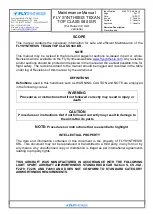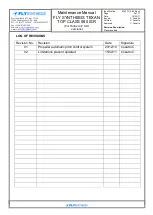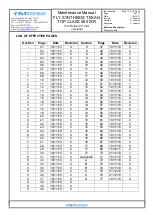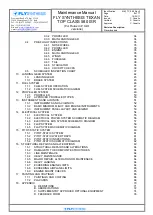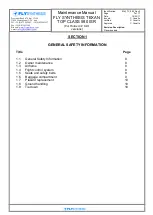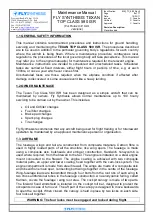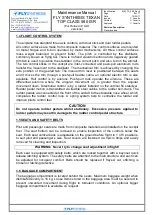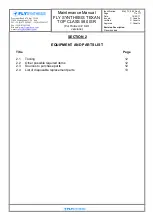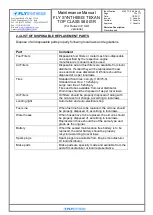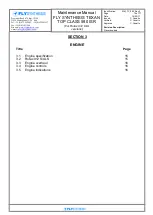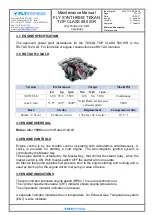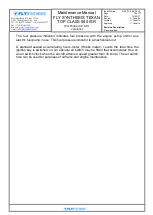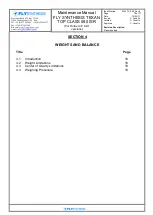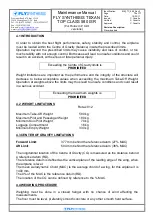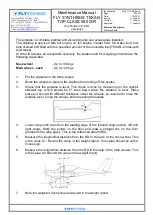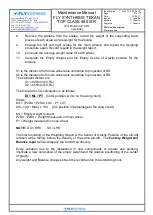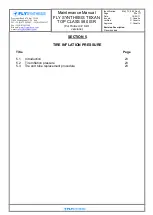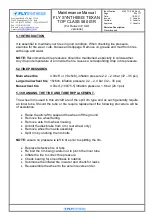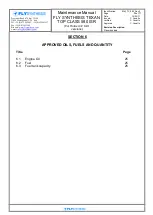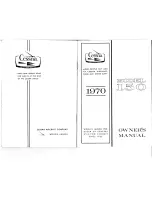
9
Provincial Road n.78 Km 12.150
33050 Mortegliano (UD) – Italy
Tel. +39.(0)432.992482 – +39.(0)432.993557
Fax +39.(0)432.931280
Sito web:
www.flysynthesis.com
e-mail:
info@flysynthesis.com
Maintenance Manual
FLY SYNTHESIS TEXAN
TOP CLASS 580 ISR
(For Rotax 912 ULS
versions)
Identification: MM_TC_580_Rev.2
Page: 9 of 77
Date: 15/02/11
Issued: C. Cosatto
Verified: C. Cosatto
Approved: C. Cosatto
Revision Description:
Placard update
1.4 FLIGHT CONTROL SYSTEM
The airplane has standard three axis controls, with dual stick and dual rudder pedals.
All control surfaces are made from composite material. The control surfaces are mounted
on metal hinges and in-turn operated by metal mechanisms. All three control surfaces
mass weight balanced to prevent flutter. The pitch is controlled by the stabilator,
commonly known as flying tail. There is no fixed elevator section and a negatively geared
trim tab is used to position the stabilator in the correct pitch and also to trim the aircraft.
The two control sticks in the cockpit are inter-connected and push-pull aluminium rods
transfer the movement to the stabilator. The mechanical trim is achieved by changing the
zero position of the geared tab. The manual trim lever is positioned between the seats
and it moves the trim through a push-pull flexible cable, an optional electric trim is also
available. Roll control is by ailerons. Push-pull rods operate the ailerons. These are
differential ailerons where the angular movement up is greater then the angular
movement down. Directional control is by a rudder installed on the vertical fin stabilizer.
Rudder pedal motion is transmitted via flexible steel cables to the rudder bell-crank. The
rudder pedals are connected at the front of the aircraft to the steerable nose wheel, which
completes the rudder control loop. A spring system help to centralize the rudder and
improve pilot‘s control feel.
CAUTION
Do not operate rudder pedals whilst stationary. Excessive pressure applied to
rudder pedals may result in damage to the rudder control pedal structure.
1.5 SEATS AND SAFETY BELTS
Pilot and passenger seats are made from composite materials and installed on the cockpit
floor. The seat bottom can be removed to enable inspection of the controls below the
seat. Each seat vertical back is adjustable on the ground before flight in 1 of 5 positions,
to suit pilot and passenger‘s size. Seat covers are fastened via Velcro strips and easily
removed for cleaning and inspection.
WARNING: Never try to change seat adjustment in flight!
Each seat is equipped with safety belts, which are locked together with a bayonet quick
release latching system. The safety belts are attached to the main structure and each can
be adjusted for occupant comfort. Belts should be replaced if frayed, cut, stitching is
broken or latching defective.
1.6 BAGGAGE COMPARTMENT
The baggage compartment is located behind the seats. Maximum baggage weight when
distributed evenly is 16 kg. Loose Items stored in the baggage area must be secured to
prevent unwanted movement during flight in turbulent conditions. An optional bigger
baggage compartment is available on request.


